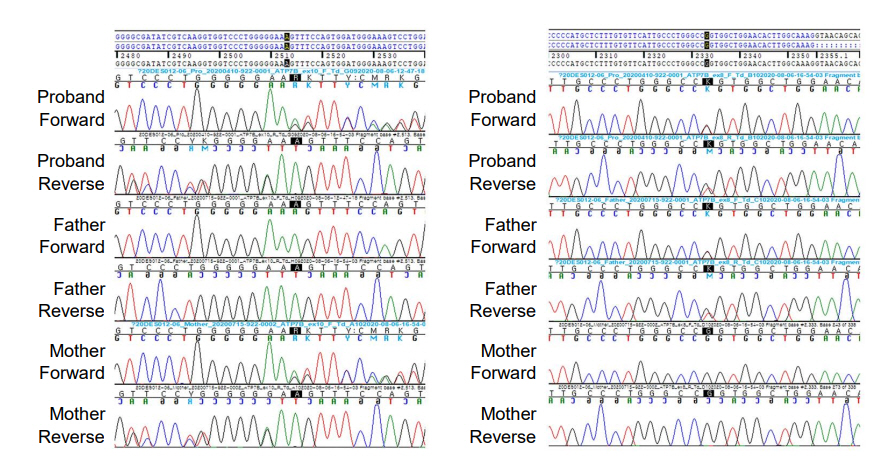Ann Pediatr Endocrinol Metab.
2022 Sep;27(3):229-235. 10.6065/apem.2142042.021.
Wilson disease diagnosed incidentally by targeted gene panel sequencing in a Korean boy with severe obesity
- Affiliations
-
- 1Department of Pediatrics, Myongji Hospital, Hanyang University Medical Center, Goyang, Korea
- 2Department of Pediatrics, Mediplex Sejong Hospital, Incheon, Korea
- 3Department of Pediatrics, Samsung Medical Center, Sungkyunkwan University School of Medicine, Seoul, Korea
- 4GC Genome, GCLabs, Yongin, Korea
- 5Department of Laboratory Medicine, Kangwon National University School of Medicine, Chuncheon, Korea
- KMID: 2533343
- DOI: http://doi.org/10.6065/apem.2142042.021
Abstract
- Wilson disease (WD) is a relatively common genetic hepatic disease in children and is characterized by excessive copper accumulation, predominantly in the liver and brain. It is an autosomal recessive disease caused by an ATP7B mutation that causes brain degeneration and is potentially fatal if diagnosed late or untreated. In the early phase of WD, its initial presentation may include mild hepatic involvement. WD may be overlooked as a cause of liver disease due to severe obesity but should not be excluded from differential diagnosis. We report a case of WD with severe obesity and fatty liver diagnosed in the early phase by targeted gene panel sequencing and review the endocrine problems associated with WD. Early suspicion of WD is important for good prognosis.
Figure
Reference
-
References
1. Scheinberg IS, Sternlieb I. Wilson's disease (a volume in the major problems in internal medicine series). Philadelphia (PA): W. B. Saunders;1984. p. 192.2. Ludwig J, Moyer TP, Rakela J. The liver biopsy diagnosis of Wilson's disease. Methods in pathology. Am J Clin Pathol. 1994; 102:443–6.3. Liggi M, Murgia D, Civolani A, Demelia E, Sorbello O, Demelia L. The relationship between copper and steatosis in Wilson's disease. Clin Res Hepatol Gastroenterol. 2013; 37:36–40.4. Wooton-Kee CR, Robertson M, Zhou Y, Dong B, Sun Z, Kim KH, et al. Metabolic dysregulation in the Atp7b (-/-) Wilson's disease mouse model. Proc Natl Acad Sci U S A. 2020; 117:2076–83.5. Tribl GG, Trindade MC, Bittencourt T, Lorenzi-Filho G, Cardoso Alves R, Ciampi de Andrade D, et al. Wilson's disease with and without rapid eye movement sleep behavior disorder compared to healthy matched controls. Sleep Med. 2016; 17:179–85.6. Sinha S, Taly AB, Prashanth LK, Arunodaya GR, Swamy HS. Successful pregnancies and abortions in symptomatic and asymptomatic Wilson's disease. J Neurol Sci. 2004; 217:37–40.7. Ala A, Walker AP, Ashkan K, Dooley JS, Schilsky ML. Wilson's disease. Lancet. 2007; 369:397–408.8. Koch A, Dörr HG, Gerlin S, Behrens R, Böhles HJ. Effect of growth hormone on IGF-I levels in a patient with growth hormone deficiency and Wilson disease. Horm Res. 1995; 44:40–4.9. Kaushansky A, Frydman M, Kaufman H, Homburg R. Endocrine studies of the ovulatory disturbances in Wilson’s disease (hepatolenticular degeneration). Fertil Steril. 1987; 47:270–3.10. Carpenter TO, Carnes DL, Anast CS. Hypoparathyroidism in Wilson's disease. N Engl J Med. 1983; 309:873–7.11. Krysiak R, Handzlik-Orlik G, Okopien B. Endocrine symptoms as the initial manifestation of Wilson's disease. Yale J Biol Med. 2012; 85:249–54.12. Golding DN, Walshe JM. Arthropathy of Wilson's disease. Study of clinical and radiological features in 32 patients. Ann Rheum Dis. 1977; 36:99–111.13. Canelas HM, Carvalho N, Scaff M, Vitule A, Barbosa ER, Azevedo EM. Osteoarthropathy of hepatolenticular degeneration. Acta Neurol Scand. 1978; 57:481–7.14. Nicastro E, Loudianos G, Zancan L, D’Antiga L, Maggiore G, Marcellini M, et al. Genotype–phenotype correlation in Italian children with Wilson’s disease. J Hepatol. 2009; 50:555–61.15. Cauza E, Maier-Dobersberger T, Polli C, Kaserer K, Kramer L, Ferenci P. Screening for Wilson's disease in patients with liver diseases by serum ceruloplasmin. J Hepatol. 1997; 27:358–62.16. Lee HW, Kang JD, Yeo CW, Yoon SW, Lee KJ, Choi MK. Hypopituitarism presenting as adrenal insufficiency and hypothyroidism in a patient with wilson's disease: a case report. J Korean Med Sci. 2016; 31:1345–8.17. Lee YK, Kim SH, Hah JS, Park CS. Endocrine study on menstrual irregularities in Wilson's Disease. J Korean Neurol Assoc. 1990; 8:312–7.18. Klee JG. Undiagnosed Wilson's disease as cause of unexplained miscarriage. Lancet. 1979; 2:423.19. Scheinberg IH, Sternlieb I. Wilson's disease. Annu Rev Med. 1965; 16:119–34.
- Full Text Links
- Actions
-
Cited
- CITED
-
- Close
- Share
- Similar articles
-
- Identification of a novel variant in the PHEX gene using targeted gene panel sequencing in a 24-month-old boy with hypophosphatemic rickets
- Genetic tests by next-generation sequencing in children with developmental delay and/or intellectual disability
- Development of an RNA sequencing panel to detect gene fusions in thyroid cancer
- Genetic Diagnosis in Neonatal Encephalopathy With Hypoxic Brain Damage Using Targeted Gene Panel Sequencing
- SPG11 Mutation in Hereditary Spastic Paraplegia with Thin Corpus Callosum Diagnosed by Targeted Gene Panel Sequencing




